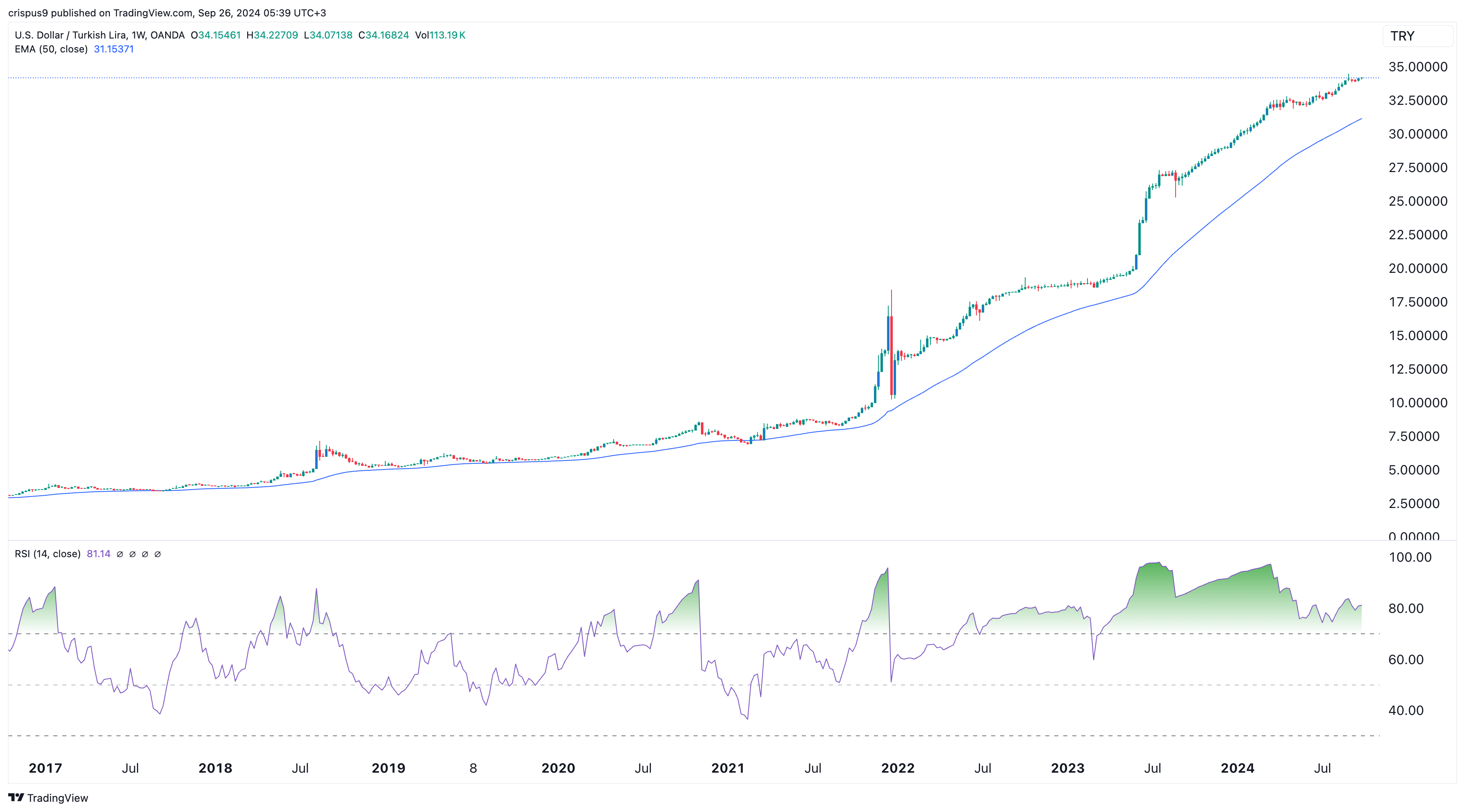The Turkish lira has moved sideways against top currencies like the US dollar, euro, and the British pound after the central bank left interest rates unchanged last week. The USD/TRY exchange rate remained unchanged near its all-time high at 34.15, while the EUR/TRY and GBP/TRY were trading at 38.11 and 45.6, respectively.
Turkey interest rate cuts hopes
The Turkish lira has remained in a tight range as investors reflect on last week’s CBRT interest rate decision.
As most analysts expected, the bank left interest rates unchanged at 50% for the seventh consecutive meeting.
Its last interest rate hike came earlier this year when it pushed them by 500 basis points to counter the stubbornly high inflation rate.
However, the bank changed the wording in its statement, signalling that officials anticipate cutting interest rates either later this year or in early 2025.
Analysts believe that the CBRT should maintain higher rates for a while, a move that will make the Turkish lira more attractive now that the Federal Reserve, Bank of England, and the European Central Banks are slashing interest rates.
Hopes of a CBRT rate cut rose after the country’s statistics agency published encouraging consumer inflation data earlier this month. These numbers showed that the headline Consumer Price Index (CPI) continued tumbling last month. It came in at 51.97%, missing the analysts estimates of 52.20%.
Turkey’s inflation has been in a strong downward trend after peaking at 75.45% in May. It dropped to 71.60% in June and 61.78% in July; analysts expect this trend to continue.
Still, Turkey has one of the highest inflation rates in the emerging markets, and cutting interest rates soon enough will likely stimulate more spending.
CBT hikes reserve ratios
Meanwhile, the CBRT has made other strategies to boost the Turkish lira. Last week, the bank made more measures to drain the lira liquidity by raising the amount of money that commercial banks need to set aside for short-term and long-term lira deposits.
The short-term reserve deposits rose from 12% to 15%, while long-term ones moved from 8% to 10%. Additionally, the Turkish lira boosted the maximum commission rate from 5% to 8%. Its goal is to manage the lira oversupply.
According to Bloomberg, its net funding to lenders has moved to almost negative 400 billion Turkish liras. This means that it has now become a borrower of liras from commercial banks, signalling that there is substantially higher liquidity in the market.
The Turkish lira has remained under pressure because analysts have started to price in a rate cut either at the December meeting or earlier next year.
Central banks are easing rates
The USD/TRY, EUR/TRY, and GBP/TRY are also reacting to central bank decisions by the Federal Reserve, ECB, and BoE.
In its central bank decision last week, the Fed slashed interest rates by 0.50%, hinting that more cuts were coming.
The case for more cuts rose after the US published weak consumer confidence report this week. Data by the Conference Board showed that the figure had the biggest drop in three years as concerns about the labor market continued. Analysts now see a series of 0.25% rate cut in the next few meetings.
The Bank of England left rates unchanged at 5% and hinted that it will continue cutting interest rates gradually. Analysts see the bank cutting rates several times in the next few meetings.
The European Central Bank slashed rates for the second consecutive meeting as Christine Lagarde remained highly dovish.
In theory, these actions by the three banks are seen as being positive for the Turkish lira. With rates falling in the US, UK, and the EU, many investors may consider taking advantage of elevated Turkish rates.
The challenge for the lira, however, is that confidence among holders has dropped as the currency has tumbled over the years. Official data shows that the currency has dropped from 1.40 in 2009 to 34 today.
As such, if one held 1 million Turkish lira in 2008, he had $714,285. Today, the same amount is equivalent to less than $30,000.
USD/TRY analysis

The weekly chart shows that the USD to TRY exchange rate has been in a strong bull run for over a decade.
This surge happened as the CBRT embraced unorthodox monetary policy, by often cutting interest rates when inflation was rising.
The pair has remained above all moving averages. On the positive side for the lira, the Relative Strength Index (RSI) has formed a bearish divergence chart pattern. In most periods, this pattern is often followed by a reversal.
Therefore, while the general USD/TRY trend is bullish, a short pullback cannot be ruled out. If this happens, the pair may drop to about 33.
The post USD/TRY analysis: what next for the vulnerable Turkish lira? appeared first on Invezz





